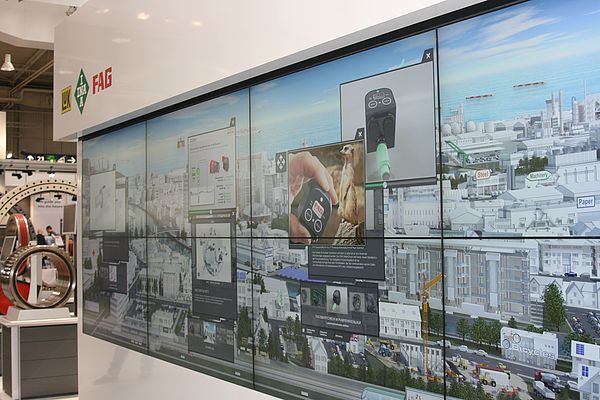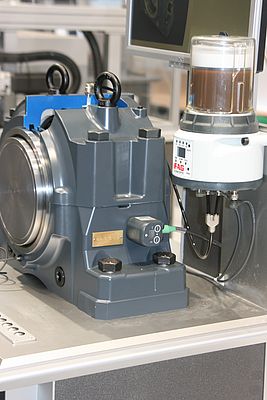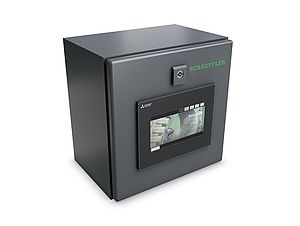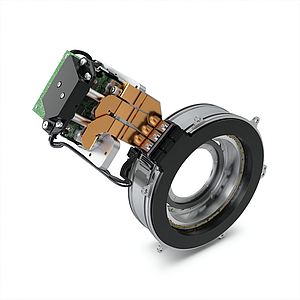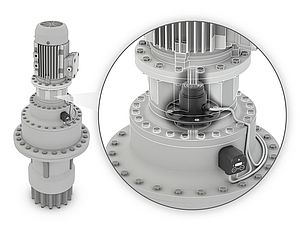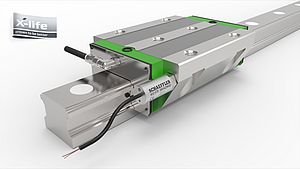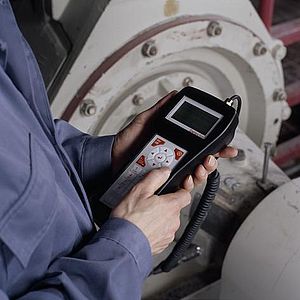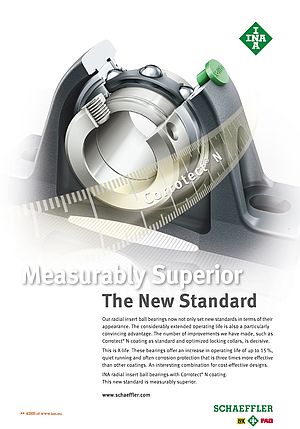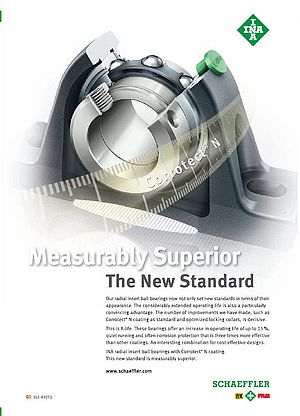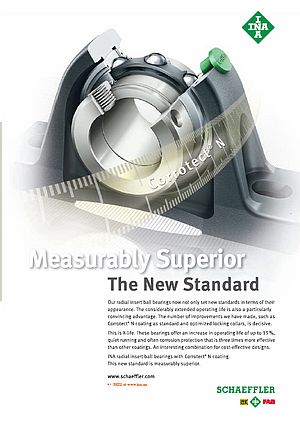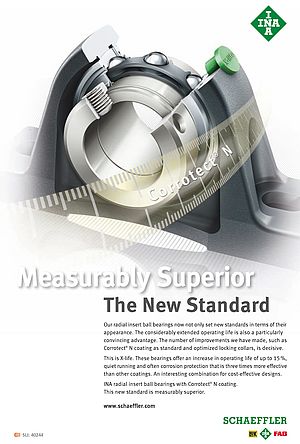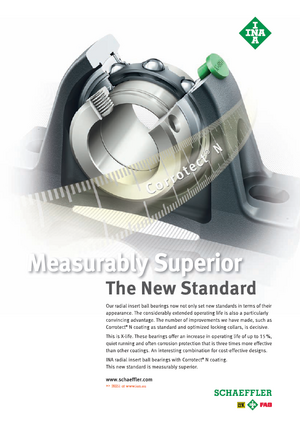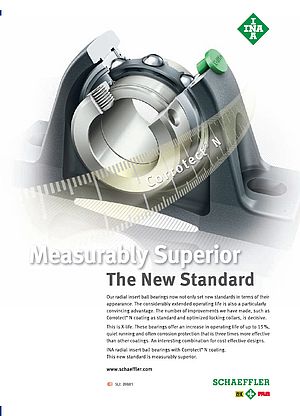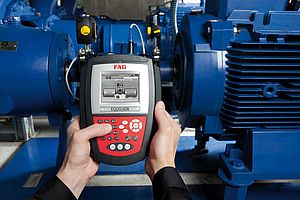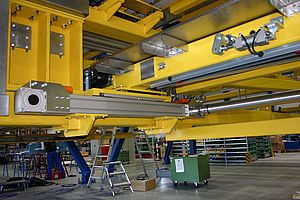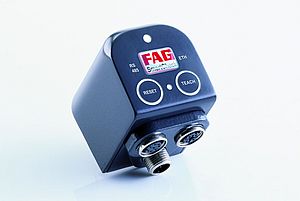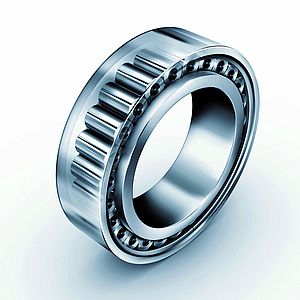This year, the IEN Europe Award for the most innovative product of the past twelve months went to Schaeffler for their FAG SmartCheck, an online condition monitoring device for industrial plant and machinery. In an online poll, more than 30 percent of the IEN readers and users voted for the system, which not only monitors vibration and temperature, but also a range of other machine and process-specific parameters such as pressure and flow rate. After handing over the award at Hannover Messe, IEN Europe talked to Diethelm Schüller, Product Manager Condition Monitoring, and Volker Erberich, Service Manager OEM, at FAG Industrial Services GmbH in Herzogenrath, Germany, about the innovative system and the acceptance of condition monitoring in general.
IEN: What are the typical applications for the SmartCheck sensor?
Erberich: The product has a very wide range of application. Generally spoken, it can be used where drive chains are involved, e.g. in electric motors, fans, pumps, compressors, or in vacuum technology. But the SmartCheck is also good for spindle machines and machine tools, as well as separators and decanters. In fact, the possibilities of application even include areas where we didn't think of at first.
IEN: What about especially sensitive applications, e.g. maintenance-critical offshore wind turbines?
Schüller: The FAG SmartCheck has already been used successfully in wind turbines. But we must not forget that this is not our only condition monitoring system. In fact, it is a very compact and cost-efficient solution. But we also offer other systems that include a variety of sensors in one. Those systems are more suitable for offshore wind turbines. One might well use the FAG SmartCheck for monitoring a local, onshore wind power station, but offshore facilities require a more complex solution that I just mentioned.
IEN: Which physical quantities can be measured by the FAG SmartCheck?
Schüller: The FAG SmartCheck measures vibrations and temperature. If desired, further machine or process parameters may be included in the monitoring. Those parameters can also be combined with each other, in order to achieve more substantial measurement results, and thus be able to gain a complete analysis of a machine or a system.
Erberich: When developing this system, we focused on keeping the three communication interfaces as open as possible. For example, in cooperation with Mitsubishi Electric we implemented a protocol from a Mitsubishi PLC into the SmartCheck via the Ethernet interface. Our aim was to enhance the process information of the control with the vibration signals from the sensor, in order to gain more substantial information that we could re-transfer in plain text to the PLC. Subsequently, the superordinate visual display system can then indicate: Unusual vibration at pump No 17 due to cavitation. Please reduce revolution! That way, we could also take measures that influence the process directly. As a consequence, the FAG SmartCheck might also be used within the concept of Industry 4.0.
IEN: Does the interpretation of the monitoring results require special knowledge? Should a user be able to read and interpret an FFT frequency spectrum, for example?
Erberich: Not at all. The majority of our customers demands a simple handling of the monitoring system. They want to know: This is my aggregate - how much time do I have to take maintenance measures? In essence, the user asks for easy-to-interpret information in the form of a traffic light function.
Schüller: Of course, in the background we collect the data that is needed to perform an in-depth FFT analysis as well, if required. But as far as the external user interface is concerned, we very much laid emphasis on the fact that the system signalises the state of a machine in an easy and unambiguous way, and enhances this information by recommendations for action. We also provide clear guidelines as to mounting and setting up the FAG SmartCheck. If, for example, a user wants to monitor a bearing, the guideline is as follows: Enter the bearing information and revolution speed. Everything else is done by the system. If necessary, one might also acquire more profound information saved within the system by using a special software, of course.
IEN: Regarding the importance of condition monitoring: Has the awareness for the subject increased among your customers, and if so, what is the reason for that?
Erberich: From my point of view one has to differentiate between the awareness on the part of the OEM on the one hand, and the end user on the other hand. Usually, the machine operator's standpoint is: I want to spend as few money as possible but have maximum security. With regard to this attitude, we developed a cost-effective system that is easy to operate. So the end user is highly interested in condition monitoring if the price is right and the device is easy to handle. We see this viewpoint very much represented here at the trade show as well. As far as our OEM customers are concerned, the acceptance for condition monitoring depends very much on the industry branch. I just talked to a manufacturer of electric motors here at the show, who said that his interest in those solutions is rather limited, but that his customers expect them from him. According to what he said, his customers are not satisfied with merely the electric motor, but want a reliable monitoring system as well. So yes, there is an interest in condition monitoring solutions on the part of the OEM as well, but this is less insight- than customer-driven. We also aim at delivering our OEMs an added value in the after sales market, so that they are able to achieve some customer loyalty by offering service and maintenance concepts. Life cycle contracting and extended warranty periods might serve as keywords here. All this is possible because of the data recorded by the FAG SmartCheck.
Schüller: Maybe it's also important to add that different industrial branches have different attitudes towards the subject of condition monitoring. The steel industry, for example, has been using condition monitoring devices for quite a while now. Other branches are rather sceptical about it and ask themselves: What added value does this technology offer to me? In the wind power industry, for instance, the attitude frequently is: Of course it is expensive for me to exchange a gearbox based on the data I got from the CM system. But when my insurance company extends the insurance period by five years because of that measure, it is only for my benefit.
IEN: 'All-round monitoring for rolling bearings' is the headline for the further development of your condition monitoring system that you launched most recently. Could you please tell us about the new product features?
Schüller: We offer different kinds of sensors. Each sensor collects specific data. The new system combines those different kinds of sensors - vibration sensor, grease sensor and oil sensor - in one unit, which provides the customer with the required information. The grease sensor measures the grease quality, the oil sensor detects the slightest traces of abrasion in the oil, and the vibration sensor provides information regarding possible damages because of this abrasion, e.g. it measures increased vibrations because of a gearwheel damage. By combining this information, we are able to deliver an in-depth analysis and thus a decisive added value to our customers. Because quite often, only by combining this data we know if maintenance is actually required or not. In a further step, the system can even be extended by a lubrication unit that provides additional lubrication if required.
Erberich: This option is also part of our show presentation here at Hannover Messe. We exhibit a plummer block housing where a grease sensor detects e.g. an inadequate water content or a turbidity or a lack of additives. If this is the case, the lubrication unit is activated via the bus line an provides the bearing with just the right amount of fresh grease, until the sensor indicates that the lubrication is ok again. In other words, we strive to not activate the vibration sensor at all, since if the grease is ok, the bearing most probably will not be damaged.



